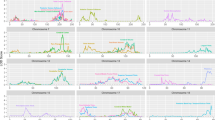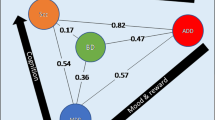Abstract
Our group first reported a linkage finding for bipolar (BP) disorder on chromosome 8q24 in a study of 50 multiplex pedigrees, with an HLOD score reaching 2.39. Recently, Cichon et al reported an LOD score of 3.62 in the same region using two-point parametric analysis. Subsequently, we published the results of a genome scan for linkage to BP disorder using a sample extended to 65 pedigrees in which chromosome 8q24 provided the best finding, an NPL score of 3.13, approaching the accepted score for suggestive linkage. We have now fine mapped this region of chromosome 8 in our 65 pedigrees by the addition of 19 microsatellite markers reaching a marker density of 0.8 cM and an information content of 0.84. After the addition of the new data, the original NPL score slightly increased to 3.25. Two-point parametric analysis using the model employed by Cichon et al obtained an LOD score of 3.32 for marker D8S256 at θ=0.14 exceeding the proposed threshold for genomewide significance. After adjusting the parameters in accordance with the ‘common disease–common variant’ hypothesis, multipoint parametric analysis resulted in an HLOD of 2.49 (α=0.78) between D8S529 and D8S256, and defined a 1-LOD interval corresponding to a 2.3 Mb region. No allelic association with the disease was observed for our set of microsatellite markers. Biologically, plausible candidate genes in this region include thyroglobulin, KCNQ3 coding for a voltage-gated potassium channel and the gene for brain adenyl-cyclase (ADCY8).
This is a preview of subscription content, access via your institution
Access options
Subscribe to this journal
Receive 12 print issues and online access
$259.00 per year
only $21.58 per issue
Buy this article
- Purchase on Springer Link
- Instant access to full article PDF
Prices may be subject to local taxes which are calculated during checkout


Similar content being viewed by others
References
Goodwin FK, Jamison KR . 1990. Manic Depressive Illness. Oxford University Press: New York.
Gershon ES, Hamovit J, Guroff JJ, Nurnberger JI, Goldin LR, Bunney WE . A family study of schizoaffective, bipolar I, bipolar II, unipolar and normal control probands. Arch Gen Psychiatry 1982; 39: 1157–1167.
Bertelsen A, Harvald B, Hauge M . A Danish twin study of manic depressive disorders. Br J Psychiatry 1977; 130: 330–351.
Mendlewicz J, Rainer JD . Adoption study supporting genetic transmission in manic-depressive illness. Nature 1977; 268: 327–329.
Risch NJ, Botstein D . A manic depressive history. Nat Genet 1996; 12: 351–353.
Berrettini WH . Genetics of psychiatric disease. Annu Rev Med 2000; 51: 465–479.
Merikangas KR, Chakravarti A, Moldin SO, Araj H, Blangero JC, Burmeister M et al. Future of genetics of mood disorders research. Biol Psychiatry 2002; 52: 457–477.
Cichon S, Schumacher J, Muller DJ, Hurter M, Windemuth C, Strauch K et al. A genome screen for genes predisposing to bipolar affective disorder detects a new susceptibility locus on 8q. Hum Mol Genet 2001; 10: 2933–2944.
Friddle C, Koskela R, Ranade K, Hebert J, Cargill M, Clark CD et al. Full-genome scan for linkage in 50 families segregating the bipolar affective disease phenotype. Am J Hum Genet 2000; 66: 205–215.
McInnis MG, Lan T-H, Willour VL, Zandi PP, McMahon FJ, Simpson SG et al. Genome-wide scan of bipolar disorder in 65 pedigrees: supportive evidence for linkage at 8q24, 18q22, 4q32, 2p13, and 13q14. Mol Psychiatry 2003; 8: 288–298.
Endicott J, Spitzer RL . A diagnostic interview: the schedule for affective disorders and schizophrenia. Arch Gen Psychiatry 1978; 35: 837–844.
Kong A, Gudbjartsson DF, Sainz J, Jonsdottir GM, Gudjonsson SA, Richardsson B et al. A high-resolution recombination map of the human genome. Nat Genet 2002; 31: 241–247.
Lathrop GM, Lalouel JM, Julier C, Ott J . Strategies for multilocus linkage analysis in humans. Proc Natl Acad Sci USA 1984; 81: 3443–3446.
Kong A, Cox NJ . Allele-sharing models —LOD scores and accurate linkage tests. Am J Hum Genet 1997; 61: 1179–1188.
Kruglyak L, Daly MJ, Reeve-Daly MP, Lander ES . Parametric and nonparametric linkage analysis: a unified multipoint approach. Am J Hum Genet 1996; 58: 1347–1363.
Cottingham Jr RW, Idury RM, Schaffer AA . Faster sequential genetic linkage computations. Am J Hum Genet 1993; 53: 252–263.
Risch N, Giuffra L . Model misspecification and multipoint linkage analysis. Hum Hered 1992; 42: 77–92.
Risch N, Merikangas K . The future of genetic studies of complex human diseases. Science 1996; 273: 1516–1517.
Rabinowitz D, Laird N . A unified approach to adjusting association tests for population admixture with arbitrary pedigree structure and arbitrary missing marker information. Hum Hered 2000; 50: 211–223.
Lander ES, Kruglyak L . Genetic dissection of complex traits: guidelines for interpreting and reporting linkage results. Nat Genet 1995; 11: 241–247.
Goldgar DE . Major strengths and weaknesses of model-free methods. Adv Genet 2001; 42: 241–251.
Sham PC, Lin MW, Zhao JH, Curtis D . Power comparison of parametric and nonparametric linkage tests in small pedigrees. Am J Hum Genet 2000; 66: 1661–1668.
Goldin LR, Weeks DE . Two-locus models of disease: comparison of likelihood and nonparametric linkage methods. Am J Hum Genet 1993; 53: 908–915.
Abreu PC, Greenberg DA, Hodge SE . Direct power comparisons between simple LOD scores and NPL scores for linkage analysis in complex diseases. Am J Hum Genet 1999; 65: 847–857.
Durner M, Vieland VJ, Greenberg DA . Further evidence for the increased power of LOD scores compared with nonparametric methods. Am J Hum Genet 1999; 64: 281–289.
Gabriel SB, Schaffner SF, Nguyen H, Moore JM, Roy J, Blumenstiel B et al. The structure of haplotype blocks in the human genome. Science 2002; 296: 2225–2229.
Maglott DR, Katz KS, Sicotte H, Pruitt KD . NCBI's LocusLink and RefSeq. Nucleic Acids Res 2000; 28: 126–128.
Baumgartner A, Bauer M, Hellweg R . Treatment of intractable non-rapid cycling bipolar affective disorder with high-dose thyroxine: an open clinical trial. Neuropsychopharmacology 1994; 10: 183–189.
Lazarus JH . The effects of lithium therapy on thyroid and thyrotropin-releasing hormone. Thyroid 1998; 8: 909–913.
Haggerty JJ, Jr., Evans DL, Golden RN, Pedersen CA, Simon JS, Nemeroff CB . The presence of antithyroid antibodies in patients with affective and nonaffective psychiatric disorders. Biol Psychiatry 1990; 27: 51–60.
Haggerty JJ, Jr., Silva SG, Marquardt M, Mason GA, Chang HY, Evans DL et al. Prevalence of antithyroid antibodies in mood disorders. Depress Anxiety 1997; 5: 91–96.
Wilson R, McKillop JH, Crocket GT, Pearson C, Jenkins C, Burns F et al. The effect of lithium therapy on parameters thought to be involved in the development of autoimmune thyroid disease. Clin Endocrinol (Oxf) 1991; 34: 357–361.
Bartalena L, Pellegrini L, Meschi M, Antonangeli L, Bogazzi F, Dell'Osso L et al. Evaluation of thyroid function in patients with rapid-cycling and non-rapid-cycling bipolar disorder. Psychiatry Res 1990; 34: 13–17.
Hornig M, Amsterdam JD, Kamoun M, Goodman DB . Autoantibody disturbances in affective disorders: a function of age and gender? J Affect Disord 1999; 55: 29–37.
Rapaport MH . Immune parameters in euthymic bipolar patients and normal volunteers. J Affect Disord 1994; 32: 149–156.
van de Graaf SA, Ris-Stalpers C, Pauws E, Mendive FM, Targovnik HM, de Vijlder JJ . Up to date with human thyroglobulin. J Endocrinol 2001; 170: 307–321.
Jentsch TJ . Neuronal KCNQ potassium channels: physiology and role in disease. Nat Rev Neurosci 2000; 1: 21–30.
Charlier C, Singh NA, Ryan SG, Lewis TB, Reus BE, Leach RJ et al. A pore mutation in a novel KQT-like potassium channel gene in an idiopathic epilepsy family. Nat Genet 1998; 18: 53–55.
Abdulla YH, Hamadah K . 3′,5′ cyclic adenosine monophosphate in depression and mania. Lancet 1970; 1: 378–381.
Young LT, Li PP, Kish SJ, Siu KP, Kamble A, Hornykiewicz O et al. Cerebral cortex Gs alpha protein levels and forskolin-stimulated cyclic AMP formation are increased in bipolar affective disorder. J Neurochem 1993; 61: 890–898.
Rahman S, Li PP, Young LT, Kofman O, Kish SJ, Warsh JJ . Reduced [3H]cyclic AMP binding in postmortem brain from subjects with bipolar affective disorder. J Neurochem 1997; 68: 297–304.
Fields A, Li PP, Kish SJ, Warsh JJ . Increased cyclic AMP-dependent protein kinase activity in postmortem brain from patients with bipolar affective disorder. J Neurochem 1999; 73: 1704–1710.
Mork A . Actions of lithium on the cyclic AMP signalling system in various regions of the brain—possible relations to its psychotropic actions. A study on the adenylate cyclase in rat cerebral cortex, corpus striatum and hippocampus. Pharmacol Toxicol 1993; 73(Suppl 3): 1–47.
Stewart RJ, Chen B, Dowlatshahi D, MacQueen GM, Young LT . Abnormalities in the cAMP signaling pathway in post-mortem brain tissue from the Stanley Neuropathology Consortium. Brain Res Bull 2001; 55: 625–629.
Acknowledgements
This work was supported by grants from the National Institute of Mental Health, the Stanley Medical Research Institute, the National Alliance for Research on Schizophrenia and Depression, the Alex. Brown & Sons Charitable Foundation, and the Charles A. Dana Foundation program ‘The Dana Consortium on the Genetic Basis of Manic Depressive Illness’. We would like to thank Dr Francis J McMahon and Dr Sylvia G Simpson for their participation in the clinical evaluations and Tyra Diggs for providing technical support.
Author information
Authors and Affiliations
Corresponding author
Rights and permissions
About this article
Cite this article
Avramopoulos, D., Willour, V., Zandi, P. et al. Linkage of bipolar affective disorder on chromosome 8q24: follow-up and parametric analysis. Mol Psychiatry 9, 191–196 (2004). https://doi.org/10.1038/sj.mp.4001388
Received:
Revised:
Accepted:
Published:
Issue Date:
DOI: https://doi.org/10.1038/sj.mp.4001388
Keywords
This article is cited by
-
A genome-wide screen for acrophobia susceptibility loci in a Finnish isolate
Scientific Reports (2016)
-
Dissecting bipolar disorder complexity through epigenomic approach
Molecular Psychiatry (2016)
-
The genetics of bipolar disorder: genome ‘hot regions,’ genes, new potential candidates and future directions
Molecular Psychiatry (2008)
-
A genome-wide association study implicates diacylglycerol kinase eta (DGKH) and several other genes in the etiology of bipolar disorder
Molecular Psychiatry (2008)
-
PP2A-Bγ subunit and KCNQ2 K+ channels in bipolar disorder
The Pharmacogenomics Journal (2007)



